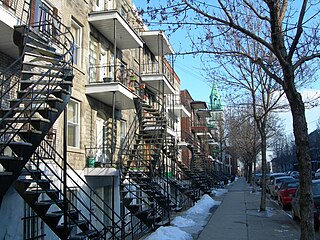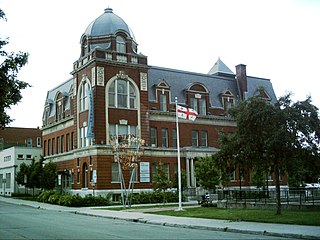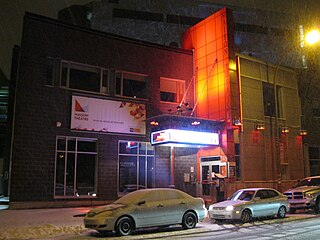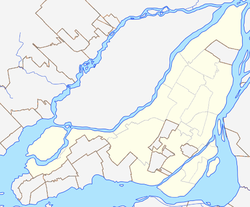
The Université du Québec à Montréal(UQAM; English:University of Quebec in Montreal;French pronunciation: [ynivɛʁsite dy kebɛk a mɔ̃ʁeal]), is a French-language public research university based in Montreal, Quebec, Canada. It is the largest constituent element of the Université du Québec system.

Boucherville is a city in the Montérégie region in Quebec, Canada. It is a suburb of Montreal on the South shore of the Saint Lawrence River.

Hochelaga-Maisonneuve is a neighbourhood in Montreal, Canada, situated in the east end of the island, generally to the south of the city's Olympic Stadium and east of downtown.

Verdun is a borough (arrondissement) of the city of Montreal, Quebec, located in the southwestern part of the island.

Frontenac station is a Montreal Metro station in the borough of Ville-Marie in Montreal, Quebec, Canada. It is operated by the Société de transport de Montréal (STM) and serves the Green Line. It is located at 2570 Ontario Street East in the Sainte-Marie neighbourhood, part of the Centre-Sud.

"Faubourg" is an ancient French term historically equivalent to "fore-town". The earliest form is forsbourg, derived from Latin forīs, 'out of', and Vulgar Latin burgum, 'town' or 'fortress'. Traditionally, this name was given to an agglomeration forming around a throughway leading outwards from a city gate, and usually took the name of the same thoroughfare within the city. As cities were often located atop hills, their outlying communities were frequently lower down. Many faubourgs were located outside the city walls, and "suburbs" were further away from this location.

Ville-Marie is the name of a borough (arrondissement) in the centre of Montreal, Quebec. The borough is named after Fort Ville-Marie, the French settlement that would later become Montreal, which was located within the present-day borough. Old Montreal is a National Historic Site of Canada.

Mercier–Hochelaga-Maisonneuve is a borough of Montreal, Quebec, Canada located in the southeastern end of the island.

Le Sud-Ouest is a borough (arrondissement) of the city of Montreal, Quebec, Canada.

Maison Radio-Canada is the broadcast headquarters, studios and master control for all French-language radio and television services of the Canadian Broadcasting Corporation including its flagship station CBFT-DT. It is also the main studio for Montreal's local English-language CBC services and the headquarters of Radio Canada International, the CBC's digital international broadcasting service.

Le Plateau-Mont-Royal is a borough (arrondissement) of the city of Montreal, Quebec, Canada.
Ville-Émard is a neighbourhood located in the Sud-Ouest borough of Montreal, Quebec, Canada.

Downtown Montreal is the central business district of Montreal, Quebec, Canada.

Little Burgundy is a neighbourhood in the South West borough of the city of Montreal, Quebec, Canada.

The Centre-Sud is a neighbourhood located in the easternmost edge of the Ville-Marie borough of the city of Montreal.

Ontario Street is an east-west artery in Montreal, Quebec, Canada. It crosses the boroughs of Ville-Marie and Mercier–Hochelaga-Maisonneuve. In the latter borough, the street becomes a mix of residential and commercial and is known as Promenade Ontario.

The Red-Light District of Montreal, Quebec, Canada was formerly centred on the intersection of Saint Laurent Boulevard and Saint Catherine Street in the borough of Ville-Marie.

Sexe de rue is a 2003 Canadian documentary film about the history and current conditions of street prostitutes in the Centre-Sud of Montreal, written, directed and co-produced by Richard Boutet, who died of a heart attack on 29 August 2003, a few days before the film's premiere at the Montreal World Film Festival. The largely first person documentary gives a voice to street workers, allowing them to tell their own stories in their own words. Prostitution is discussed as labour and in the context of local history and relevant sociological factors, including dangers.
The boroughs of Montreal, like the rest of Canada and the world, have been individually impacted by the COVID-19 pandemic.




















